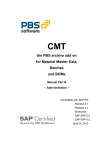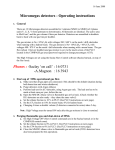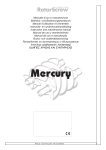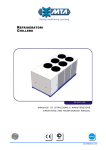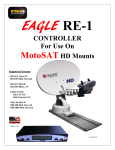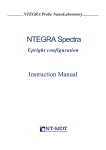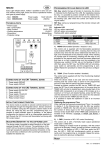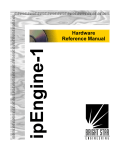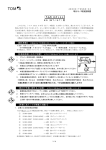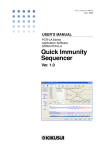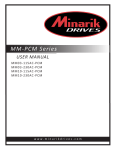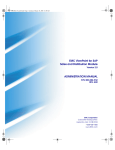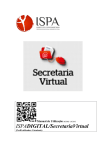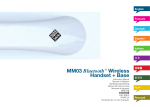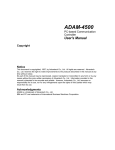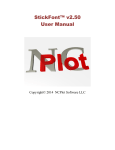Download PBS archive add on CMT - Manual Part C - User Manual -
Transcript
CMT the PBS archive add on for Material Master Data, Batches and BOMs Manual Part C – User Manual – Compatible with - SAP ERP 2004 April 24, 2013 PBS archive add on CMT for SAP ERP 2004 - User Manual - © 1999 - 2013 PBS Software GmbH Schwanheimer Strasse 144a 64625 Bensheim, Germany Phone: +49 - 6251 - 174 0 Fax: +49 - 6251 - 174 174 Email: [email protected] Internet: www.pbs-software.com PBS archive add ons is a registered trademark of PBS Software GmbH, Bensheim. SAP, R/2, R/3, SAP ERP, SAP NetWeaver, ABAP/4 are registered trademarks of SAP AG, Walldorf/Baden. Acrobat Reader is a registered trademark of Adobe Systems Incorporated. 2 PBS archive add on CMT for SAP ERP 2004 - User Manual - Introduction to the PBS ILM Concept Information Lifecycle Management Information Lifecycle Management (ILM) means the administration of information related to the time when it is used, taking into account its total costs and compliance. A conclusive, efficient ILM concept must, as a result, control data growth, manage retention rules, and also ensure compliant data storage. Furthermore, an easy access to archived data is decisive and, for example, its transfer during internal and external audits. PBS ILM Concept PBS software provides existing SAP customers extensive solutions to put into practice the requirements that were described above for a stringent and successful ILM concept. PBS is considered as an expert for complex, integrated data accesses to archived and database data and meanwhile, also to data that is located on decommissioned SAP systems. In addition to classical SAP data archiving, SAP BI-specific nearline storage is also supported. PBS archive add ons® PBS archive add ons always rely on SAP archiving having been carried out successfully. This is the basis for a permanently high-performing SAP system. In principle, you can indeed retain posted documents in the SAP database for a very long time due to a large database capacity. Depending on the document volume, this may result, however, in massive performance losses and, sooner or later, heavily increasing operation costs. The daily backup becomes difficult for large data stocks, for example. A convenient display and evaluation of archived transaction data – as the SAP user is used to for database data – can often only be carried out in a very restricted manner using SAP standard means depending on the application module. This is particularly the case for large archive data stocks. The PBS archive add ons can be used here. They can be provided for nearly all SAP modules and release levels, and start with a "C" (for Complete) in their description. For example, PBS archive add on CCOPA for the SAP module COPA. Using the PBS archive add ons you can quickly and easily access your archived data even after data archiving during your day-to-day business. The unrestricted data access is realized by an intelligent indexing concept. It extends the SAP archive infrastructure components and integrates itself optimally with SAP archiving. Archive data that has been indexed can still be provided after a release upgrade immediately, without restrictions, and without migration effort. The PBS archive index is stored in sequential files of the SAP file system in the same way as the SAP archive data. Afterwards, you can access the archive data online via the familiar transactions. The SAP user can display the data from the SAP database and the archive data simultaneously via the PBS archive add on index. For the user, it seems as though the archived data is still in the SAP database. The deep integration of the PBS transactions also enables direct navigation to subsequent and previous documents both within the indexed SAP module as well as to linked documents from other SAP modules. This applies not only for resident but also without restrictions for archived data. The benefit for the user increases the more PBS archive add ons are used. The potential benefits of the ILM concept raises substantially if you take into account the savings that result from the SAP mirror systems. There are usually at least two of them meaning that the saved disk storage can be tripled by performing data archiving. Thus, time is saved for the data backup. 3 PBS archive add on CMT for SAP ERP 2004 - User Manual - Table of Contents 1. Introduction 5 2. Application Functions 6 2.1. 2.2. 2.3. 2.4. 2.5. 2.6. 2.7. 2.8. 2.9. 3. Navigation within the PBS archive add on CMT up to 4.5x Navigation in the PBS archive add on CMT from 4.6 Transaction Overview Display Transactions for Material Master Data Material Master Data Changes Create Material from Copy CMT Display Batches Display Bill of Material Transactions with Selection List ABAP/4 Interfaces 3.1. 3.2. Access via ABAP/4 Routines Access via PBS Function Module 6 7 8 10 14 15 16 18 20 22 22 23 4 PBS archive add on CMT for SAP ERP 2004 - User Manual - 1. Introduction The PBS archive add ons are constructed in modular form and cover the application modules FI, SD, MM, CO etc. with a special program package for exactly this application. You can easily see from the name which PBS archive add on belongs to which SAP module: CFI, CSD, CMM, CCO etc. All PBS archive add ons have in common that they can be easily installed in the SAP R/3 system via the SAP transport utilities "tp" and “SAINT”. For installation details of the PBS archive add ons please see the specific installation manual (manual part A). This manual on the display transaction and application programs was written to support you when using the PBS archive add on CMT. Please see the administration manual (part B) regarding construction and administration of the PBS archive add on CMT. The modular user manual of each PBS archive add on is composed of partial manuals: - Part A: Installation - Part B: Administration, Archive Construction and Maintenance - Part C: Application Programs / Transactions - Part D: Migration Support R/2 => R/3 (if available) There are additional manuals for the PBS utilities: Conversion Tool, Archive Browser, Translation Tool. Should you have questions regarding the installation of the PBS archive add ons or if you have problems when installing the software please call directly the Service Hotline of PBS Software GmbH: Phone: +49 - 6251 - 174 110 Fax: +49 - 6251 - 174 174 email: [email protected] Release Compatibility The PBS archive add on CMT discussed in this manual runs with the basis programs of SAP AG, 69190 Walldorf/Baden, releases ECC 5.0. 5 PBS archive add on CMT for SAP ERP 2004 - User Manual - 2. Application Functions 2.1. Navigation within the PBS archive add on CMT up to 4.5x PBS has integrated in its software a start menu which corresponds to the SAP standard menu S000 after having registered in the SAP system. The only difference is the additional function button "PBS archive add ons". In order to use this menu, you only have to enter start menu "YPBS" for users up to 3.1 respectively "/PBS/PBS" for users in all 4.0 releases and /PBS/PBS_45 from release 4.5. After pressing the button, you get to the main menu transactions for the PBS archive add ons, by which you can address the different modules in a comfortable way. Diagram 1: PBS main menu with branching off to PBS archive add on CMT 6 PBS archive add on CMT for SAP ERP 2004 - User Manual - 2.2. Navigation in the PBS archive add on CMT from 4.6 From the Easy Access menu you can easily navigate via the button 'User menu' through the functions of the PBS archive add on CMT. This is possible when your system administrator has added the role/activity group to your user profile. Diagram 2: Navigation via SAP Easy Access 7 PBS archive add on CMT for SAP ERP 2004 - User Manual - 2.3. Transaction Overview For the PBS archive add on CMT the following transactions relevant for the user are provided. The display transactions show documents form the SAP database and from the PBS archive add on CMT. PBS Transaction SAP-Trans. Description /PBS/PBS - Main menu PBS archive add ons /PBS/CMT - Menu of the PBS archive add on CMT /PBS/MM03 MM03 Display material current status /PBS/MM05 MM04 Display changes for material /PBS/MM19 MM19 Display material at key date /PBS/ZMRM MM01 Create Material from Copy CMT /PBS/MSC3 resp. /PBS/MSC3N (from 4.6) MSC3 resp. MSC3N Display batch /PBS/MSC4 resp. /PBS/MSC4N (from 4.6) MSC4 resp. MSC4N Display changes batch /PBS/IB80 IB80 Change documents: equipment BOM /PBS/IB81 IB81 Change documents: technical location BOM /PBS/IB03 IB03 Display equipment BOM /PBS/IB13 IB13 Display techn. location BOM /PBS/CS03 CS03 Display material BOM /PBS/CS06 CS06 Material BOM: display BOM group /PBS/CS09 CS09 Material BOM: display plant allocation /PBS/CS11 CS11 Expand BOM: multi-level BOM /PBS/CS12 CS12 Expand BOM: multi-level structure /PBS/CS13 CS13 Expand BOM: quantity overview /PBS/CS14 CS14 Comparison of BOMs Table 1: Transactions of PBS archive add on CMT (part 1) 8 PBS archive add on CMT for SAP ERP 2004 - User Manual - 9 PBS Transaction SAP-Trans. Description /PBS/CS15 CS15 Usage: material /PBS/CS42 CS42 Material BOM: display allocation config. material /PBS/CS63 CS63 Display customer order BOM /PBS/CS80 CS80 Change documents: material BOM /PBS/CS81 CS81 Change documents: standard BOM /PBS/CS82 CS82 Change documents: customer order BOM /PBS/CSC5 CSC5 Usage: class single-level /PBS/CSD5 CSD5 Usage: document single-level /PBS/CV13 CV13 Display document BOM /PBS/CV80 CV80 Change documents: document BOM Table 2: Transactions of PBS archive add on CMT (part 2) PBS archive add on CMT for SAP ERP 2004 - User Manual - 10 2.4. Display Transactions for Material Master Data The PBS transactions for the display of material master data are nearly identical to the SAP transactions, therefore, no special training for the user is necessary. In the selection screen the differences between the PBS transactions and the SAP original are the text in the window header and the other menu points which are inactive. In addition, you can use the “Search” button to look for a material short text not only in the residence data but also in the archive data. Diagram 3: The screen of the PBS transaction /PBS/MM03 Diagram 4: Search via material short text In the course of the transactions you can see the difference between the PBS- and the SAP transactions with the help of the archive indicator "*". PBS archive add on CMT for SAP ERP 2004 Diagram 5: The symbol "Archive *" marks the difference - User Manual - 11 PBS archive add on CMT for SAP ERP 2004 - User Manual - Important note: Customer-specific adaptations of the views within the material master display A user who has corresponding authorizations can adapt individually the views of the material master data using SAP Customizing. This can have the effect that, for example, customer-specific subscreens are displayed in the view (also called "data screen" in Customizing) "Basic data" or a completely new view can be displayed in the SAP standard transaction MM03 that does not exist in the standard views or standard screen sequences (for example "01" or "21"). For this, the system administrator has to create a customer-specific screen sequence starting with the letter "Y" or "Z" (for example "ZB") in which the new subscreens or views are called (transaction "OMT3B"). This is performed with a customer-specific function group (also starting with "Y" or "Z") and respective screens or subscreens. Diagram 6: Customizing material master display (transaction OMT3B) 12 PBS archive add on CMT for SAP ERP 2004 - User Manual - By default, the transaction /PBS/MM03 cannot display these newly added screens. A runtime error would usually occur. To avoid this, the standard screen sequence "21" that exists in each system is called instead of the views of the customerspecific screen sequence "ZB" when the transaction is executed. Thus the runtime error is bypassed. If it is important to the customer, however, that the archive data is also displayed in the normal individual way, this can only be accomplished with an adaptation in the PBS namespace. Existing customer-specific function groups have to be copied within the PBS namespace and, if required, adapted to the archive data access. This is a deviation from the SAP standard and is provided by PBS as an adaptation at additional cost. 13 PBS archive add on CMT for SAP ERP 2004 - User Manual - 2.5. Material Master Data Changes The transaction /PBS/MM05 branches off to the display of the material master data changes. With the help of this transaction, the change documents of the material master data are displayed. The display of the material master data changes of the PBS archive add on CMT is connected with the general display functionality of the PBS archive add on CCU "Master Data Change Documents". Thus, you can display from PBS archive add on CMT also the material master data changes originated from R/2. Diagram 7: Display material master data change doc. R/2 and R/3 14 PBS archive add on CMT for SAP ERP 2004 - User Manual - 2.6. Create Material from Copy CMT The transaction /PBS/ZMRM allows to create a new material master record in the database. As reference, a material master record from the PBS archive add on CMT is used. The new master record can be in another plant, warehouse location, sales organization etc. If no further information is entered for the new organization units, the old ones are copied. In case that no old organization units are indicated all lower segments of the material are created. Diagram 8: Create material with all warehouse locations in new plant 15 PBS archive add on CMT for SAP ERP 2004 - User Manual - 2.7. Display Batches The transaction /PBS/MSC3 resp. /PBS/MSC3N (from 4.6) can be used to display batches from the PBS archive add on CMT and SAP data base. Also in the following screen you can see the archive asterisk which shows the origin of the data. Diagram 9: Display batch from PBS archive add on CMT 16 PBS archive add on CMT for SAP ERP 2004 - User Manual - In the next diagram the change documents of the batch are displayed. These can also be displayed from the PBS archive add on CMT. Diagram 10: Display change documents of batch 17 PBS archive add on CMT for SAP ERP 2004 - User Manual - 2.8. Display Bill of Material The display transaction for bills of material /PBS/CS03 can also display BOMs from SAP database and from PBS archive. In case of recreating the BOM after archiving – or even multiple archiving of the same BOM – an additional selection screen is displayed as shown in the diagram below. From this screen you can branch off by a double click. Diagram 11: Selection screen when BOM number multiple exists After you have selected a bill of material, the familiar screen is displayed. 18 PBS archive add on CMT for SAP ERP 2004 - User Manual - Diagram 12: Display Bill of Material from PBS archive add on CMT 19 PBS archive add on CMT for SAP ERP 2004 - User Manual - 2.9. Transactions with Selection List A selection list is displayed for transactions /PBS/MM03 (display material master data) and /PBS/CS03 (display material BOM) if several identical material master records or material BOMs exist (also see Diagram 11). This is always the case for example, if a material master record was archived and then a material master record was recreated with the same description in the database. This master record could be archived again after some time and then a new identical material can be created. Thus you could have 2 materials from the archive and one from the database in the selection list. By a double-click the user can select the one he needs, for example using the creation date or the material text. Diagram 13: Selection list Material Master for transaction /PBS/MM03 Then as usual you can go to the view selection in the transaction /PBS/MM03 or to the item overview in the transaction /PBS/CS03. 20 PBS archive add on CMT for SAP ERP 2004 - User Manual - As already mentioned, currently, this functionality is only provided for the transactions /PBS/MM03 and /PBS/CS03. To implement such a selection list in other transactions, for example /PBS/CS11 (explode BOM: level by level), /PBS/CS12 (explode BOM: multi-level BOM), /PBS/CS13 (explode BOM: summarized BOM), etc. cannot be realized for the following reasons: Due to technical and design-specific peculiarities it is not possible to display the BOM explosion of a requested BOM if identical BOMs (max. once in the database and one time or several times in the archive) exist. On the one hand, in the case of the multiple archiving of an identical BOM, the SAP archiving (ADK files) data has not a special hint which items belong to which BOM. On the other hand, with SAP archiving it is possible to archive some specific items with regard to the validity of their dates and the other items remain in the database. Thus the BOM data or the respective items can be distributed to several SAP ADK files that originate from different SAP archiving runs. There are also other criteria for the SAP standard archiving that make it possible to distribute a BOM to several runs during archiving. These can involve the fields plant, BOM usage and alternative BOM. A correct display with regard to the BOM and its items is not possible for identical BOMs which exist more than once due to the SAP archiving design and therefore, it also cannot be provided by PBS. 21 PBS archive add on CMT for SAP ERP 2004 - User Manual - 3. ABAP/4 Interfaces The following chapter describes the methods and auxiliary programs for the access to the data archived with the PBS archive add on CMT. This data can be accessed via the ABAP/4 routines provided by PBS or via a function module. 3.1. Access via ABAP/4 Routines All important routines required for the access to the archive data are stored in the ABAPs /PBS/CMTMREAD, /PBS/CMTOREAD, /PBS/CMTSREAD. In the following table there are example ABAPs for the usage of the routines listed. up to Rel. 4.6 from Rel. 4.7 Description /PBS/CMTM0001 /PBS/CMT_TSRD_MU002 Test access Material master data /PBS/CMTO0001 /PBS/CMT_TSRD_OU002 Test access Batches /PBS/CMTS0001 /PBS/CMT_TSRD_SU002 Test access 1 BOMs /PBS/CMTS0002 /PBS/CMT_TSRD_SU003 Test access 2 BOMs Table 3: Test access routines of PBS archive add on CMT 22 PBS archive add on CMT for SAP ERP 2004 - User Manual - 23 3.2. Access via PBS Function Module The function module "/PBS/SELECT_INTO_TABLE" accesses the PBS archive add on and exports the data records of the requested table to an internal table. The function uses the following interfaces: Name Description Type Optional Example ARCHIV Name of archive Parameter 'CMT' TABNAME Table name Parameter 'MARC' SCHL1_NAME Name key 1 Parameter X 'MATNR' SCHL1_VON Smaller value key 1 Parameter X '0' SCHL1_BIS Higher value key 1 Parameter X '1' SCHL2_NAME Name key 2 Parameter X 'WERKS' SCHL2_VON Smaller value key 2 Parameter X '0' SCHL2_BIS Higher value key 2 Parameter X '1' SCHL3_NAME Name key 3 Parameter X '' SCHL3_VON Smaller value key 3 Parameter X '' SCHL3_BIS Higher value key 3 Parameter X '' SCHL4_NAME Name key 4 Parameter X '' SCHL4_VON Smaller value key 4 Parameter X '' SCHL4_BIS Higher value key 4 Parameter X '' I_TABELLE Name of return table Table SCHL1_IN Select option key 1 Table X S_MATNR SCHL2_IN Select option key 2 Table X S_WERKS SCHL3_IN Select option key 3 Table X SCHL4_IN Select option key 4 Table X ITAB1 Table 4: Parameter of conversion tool Adjustment of the command SELECT to the PBS archive add on PBS archive add on CMT for SAP ERP 2004 - User Manual - As the data of the PBS archive add on is not contained in the database, you cannot access this data via the command "SELECT". Existing ABAPs, therefore, must be modified via the function key for the access to the archive data. Basis The SELECT command used in ABAP possesses one of the three basic characteristics which have to be adjusted if you want to use the function module. These are: 1. Select ... Endselect 2. Select into Table 3. Select Single The archive accesses are optimized by transferring the key parameters to the function. If the command SELECT uses only these key parameters for the selection, the restriction WHERE may not be necessary for the archive data. The adjustment of the three select types to the function modules is made according to the following pattern. Select-Type 1 Select und Endselect: SELECT * FROM table INTO field WHERE condition Coding ENDSELECT Characteristic INTO or APPENDING restriction is missing or the addition ‚TABLE„ is missing in both restrictions. Modification Redirect select in iTab, call function, process iTab with loop and endloop and allocate Field = iTab. 24 PBS archive add on CMT for SAP ERP 2004 - User Manual - SELECT * FROM table INTO TABLE iTAB WHERE condition Call Function function module... Loop at iTab WHERE condition Move-Corresponding iTab to field Coding Endloop Select Type 2 Select into Table: SELECT * FROM table into Table iTab WHERE condition Coding Characteristic Addition 'TABLE' in the INTO or APPENDING restriction. Modification Call function and transfer table iTab, delete data records from iTab which do not correspond to the WHERE restriction. SELECT * FROM Table into Table iTab WHERE condition Call Function function module ... Delete iTab WHERE NOT condition Coding Select Type 3 Select Single: SELECT SINGLE * FROM table WHERE condition Coding 25 PBS archive add on CMT for SAP ERP 2004 - User Manual - Characteristic Mark by addition "SINGLE". "TABLE" is not allowed. Modification Check if Select Single on residence data was unsuccessful, then call function, process once iTab with Loop and End loop, allocate field = iTab. SELECT SINGLE * FROM Table WHERE condition IF SY-SUBRC NE 0 Call Function function module... Loop at iTab WHERE condition EXIT Endloop Move Corresponding iTab to field Endif Coding 26



























